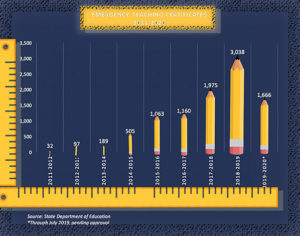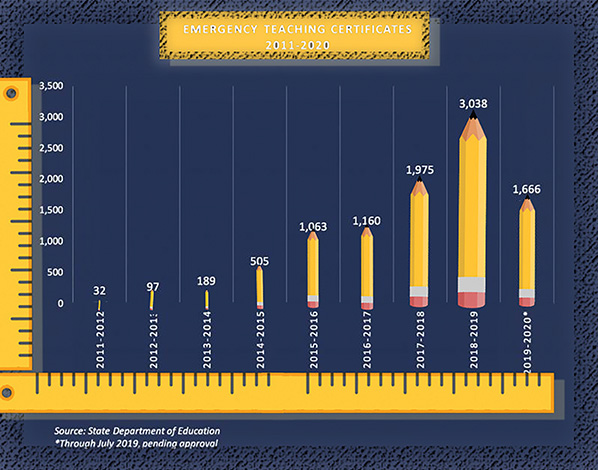by Capri Gahr, Student Reporter

Strikes ignite the match between Oklahoma political leaders and public school teachers.
In 2018, large strikes by teachers state wide lead the fight to better the public education system in Oklahoma. What they actually achieved was far less than they set out to do, but was the only major legislative changes resulting in a positive impact for teachers that Oklahoma has seen since the 1990’s.
The Legislature passed a historic funding package that increased teacher salaries by an average of $6,100, but put very few additional dollars into the state aid formula to help restore over a decade of budget cuts.
In a republican lead state that has pursued tax and service cuts for years, teachers won a raise that varies in amount and depends on experience, while members of schools’ support staff will see a raise of around $1,250. This raise, however positive, has still left teachers and public schools in need. After the 2015 changes in educational requirements and standards, teachers feel a large amount of strain while trying to maintain curriculums while balancing their allocated budgets. Budgets in classrooms press teachers into corners when the regulations pressed on them do not mirror what they are capable of doing with their money.
Alicia Priest, the Oklahoma Education Association’s 97th president taught English and Spanish in Yukon Public Schools for 16 years. Priest said Wednesday that her group hasn’t ruled out another walkout during session if legislators don’t adequately increase teacher pay and classroom funding. This increase could help the teachers that are backed into corners when their budget could adequately provide for their curriculum expectations.
Priest said members are demanding lawmakers increase public school funding by another $400 million by April 1. That includes a $3,000 raise for classroom teachers, a $2,500 raise for support personnel and another $150 million to help bolster classroom spending. Classroom spending is what teachers are lacking now and causing the firm supply of crowdfunding and charity requests. Priest believes the raises will help their own pockets but will most likely end up in the classroom in the form of school supplies.
She believes that these demands have to be met to ensure a prosperous future that ends the displeasure of teachers; often referred to as the Oklahoma Public Education Crisis and Teacher Shortage in many headlines being reported around the country.
Morgan Glover, a first year teacher in Aline-Cleo’s fourth grade class, believes that pay is a prime suspect of Oklahoma’s public school crisis. “Teachers make more in other states,” Glover said. “I am sure that a big part of the problem is administrators mishandling things too.” State general funding is nearly $180 million less than ten years ago, while K-12 enrollment has grown by over 50,000 students.
Carrie Burckhardt, a member of the department of education’s staff who works closely in ensuring media access to the department stated, “this year, the priority was to increase state funding so that schools could begin to reduce class sizes, hire additional staff and school counselors, and bring back programs such as art and music.”
Joy Hofmeister currently serves as 14th Oklahoma’s State Superintendent of Public Instruction since 2015. In 2014, the Legislature voted to repeal Common Core academic standards in English and math and decided to develop a replacement set of standards that had to be in place within two years. Supporters proclaimed the new state-developed standards would make Oklahoma a national leader. When asked about her involvement with the repeal and replacement, Hofmiester said, “it was repealed in 2014 and when I was seated in 2015, my team was stuck with formulating regulations to replace it.” She also said the replacement was ushered in with teachers and administrators all over the state by her side. She believes that her work with those teachers and administrators was strong in helping replace standards and create new regulations fir for the needs of the state. Research articles supported by her department show great increases in success while national reviews heavily disagree.
In a late 2018 report, the Thomas B. Fordham Institute examined Common Core standards and the standards of states that haven’t adopted Common Core. It stated, “Oklahoma’s math standards are weak and require significant revisions.” To cite just one problem, the institute went on to conclude, “there are no explicit expectations for the instant recall of the addition and multiplication facts among elementary students.” The reviewers concluded Oklahoma’s math standards “amount to weaker preparation for college and the workplace …”Hofmiester was asked to respond to these findings and believes they have to have been using outdated data. “Those things are true in 2015 regulations,” she said. “What is happening now is simply not supported by that study, we have seen a lot of positive impact from the new regulations.”
Megan Brown, a Northwestern News Writer and senior mass communications student, reported in the first part of this three-part investigation, that some teachers feel that the states handling of funding to schools with richer community taxes are reaping a much higher budget than those communities absent of rich industry taxes.
Nick Lyon, an English teacher at Crescent High School, has seen nine years of legislation affect the classrooms he has taught in.
One concern Lyon expressed was that of Oklahoma’s formula to regulate funding in the excess and absence of oil taxes in communities.
“Logan County, for instance, has zero oil drills or oil wells as all so like all four of the schools in Logan county are really poor and struggling,” Lyon said.
The state funding formula is intended to prevent smaller, rural districts from being left behind.
According to TulsaKids Magazine’s reporter, Claire Combs, “before state aid is distributed, local sources of revenue such as property taxes are subtracted from a district’s allocation.”
Hofmiester confirmed this statement when asked if any regulation goes into effect to even out funding for those industry-deprived districts.
“There are schools that get zero state funding,” she said. “Schools with high oil incomes and taxes benefit so greatly from them that the state doesn’t need to provide them with any supported funding.”
In theory, the fact that some schools do not get extra funding should even out any surplus and drought of money to those districts.
Kevin Cosper, a Northwestern Alum and first year Timberlake math teacher, brought to attention the fact that the school he graduated from sometimes had to rely on donations to fill holes in funding.
“Our library received donations of books from a prison once,” Cosper said.
He went on to report that the cafeteria routinely filled empty stomachs with food from foodbanks due to the lack of money flow to serve lunches.
When Hofmeister was informed of this experience, she went on to describe the formula further, “the wealth of the community is also a factor to the funding formula.” She went on to say, “communities reporting larger taxes receive less funding.”
This could mean that communities surrounded by industries like farming will get less state funding due to the incomes and taxes reported by those farmers.
A problem may arise with this because they do not take into account whether or not those farmers have children in the district, which means there is severely less income from those farmers to the school that the formula does not take into account.
Everyone may pay their fair share of taxes, but those with larger incomes and no children in school will not be paying parts into common school budgets like paying for meals, providing supplies and paying dues to clubs and activities that smaller schools use parental support to put on.
The issues for Oklahoma teachers goes further than the state level.
Paola Ponce-Villalobos, a first year math teacher at Turpin schools, sent out a notice to fellow education majors, parents, community members and friends that she had five students unable to provide their own schools supplies. Benefactors stepped in to help her make up the deficit when she had spent all the money she could from her own pocket to fill empty desks.
Reports of Funding advertisements, like the popular site Go Fund Me, and even Facebook posts pleading for help to buy simple items like Crayons, were a common sight to see in the beginning weeks of school. These goes back to the classroom spending budget that Priest said had to be improved as soon as possible. Scrolling through social media, Glover pointed out six different friends of hers, all teachers, that have posted requests for community intervention to help them get supplies.
Ponce-Villalobos said, “I have two brothers in my class with three other siblings that have a single parent working three jobs just to feed them. They simply can’t make those purchases.”
Hofmiester agreed that the gaps that parents’ cannot bridge to provide for their children is too much for teachers to bare. “We have one of the highest percentages of reduced lunch applications in the country,” she said. “Our department is currently trying to address this and it was even a key point in my testimony to congress a few weeks ago (Sept. 11.).”
Glover, along with Melissa Maharry, a teacher in the Alva school district, and Chris Eckhardt, a high school English teacher in Alva, brought up the idea that new teachers are underprepared in many ways for what they are walking into. Maharry believes her special education training benefited her more in her classroom than the classes directed specifically for her to teach elementary classes.
Burkhardt’s original statement, citing that the department is putting effort into ensuring proper education to teachers in situations that require them to act as councilors was supported by the fact that the department just introduced an event they call Bridges to Hope: Teaching In The Shadow of Trauma.
Hofmiester invites any future teachers and administrators and current one to attend the trauma summit. “Along with amending a budget appropriate for teachers to meet regulations, this is another step we are taking to ensure students can receive what they need to be successful,” she said. This is the way they see fit to address those concerns brought up by Maharry, Eckhardt and Glover.
In the end, Priest is preparing future walkouts, teachers like Glover and Villalobos will continue their pursuit of charity to fill holes in pockets and supplies in desks, Lyon and Maharry will have watched the years of regulation changes have effects on their students and Hofmeisters department will have more work to do.

